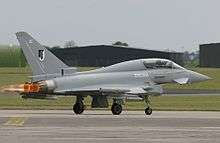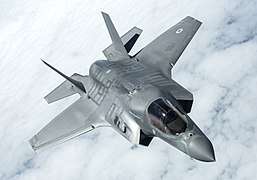No. 17 Squadron RAF
| No. XVII Squadron RAF | |
|---|---|
 | |
| Active |
|
| Country |
|
| Branch |
|
| Type | Flying squadron |
| Role | Test and evaluation |
| Home station | Edwards AFB, California |
| Motto(s) |
Excellere Contende (Latin for Strive to excel)[1] |
| Aircraft | Lockheed Martin F-35B Lightning II |
| Battle honours | * Honours marked with an asterisk may be emblazoned on the Squadron Standard |
| Insignia | |
| Squadron badge heraldry | A Gauntlet symbolizing armed strength and previous operation of the Gloster Gauntlet fighter in the 1930s. |
| Squadron roundel |
 |
No. 17 Squadron (sometimes written as No. XVII Squadron) is a squadron of the Royal Air Force. It was reformed in April 2013 as the Operational Evaluation Unit for the F-35 Lightning II.
History
World War I
The first No. 17 Squadron was formed in the Royal Flying Corps in February 1915 at Gosport. It served in the Middle East. It claimed 26 aerial victories, and had two flying aces, future Air Marshal Sir Gerald Gibbs (RAF officer) and Gilbert W. M. Green, within its ranks.[2] After a period of training embarked for Egypt in November. On 24 December, it began to make reconnaissance flights over the Turkish lines in Sinai, also flying in support of troops engaged with Turkish army units in the Western Desert. Detachments were also to be found in Arabia until July 1916, when the Squadron was sent to Salonika as a mixed unit of twelve BE2cs for reconnaissance and a scout component of two DH2s and three Bristol Scouts. At first it was the only RFC unit in Macedonia but was later joined by others in April 1918, handed over its fighters to a newly formed No 150 Squadron. For the rest of the war, it was engaged in tactical reconnaissance and artillery spotting on the Bulgarian border.
Between the wars
In December 1918 the squadron re-equipped with twelve DH9s and six Camels, sending A Flight to Batum to support the White Russian forces and B and C Flights to Constantinople in January 1919. On 14 November 1919, No 17 was disbanded.
Reforming at Hawkinge on 1 April 1924, with Snipes No 17 formed part of the fighter defence of the UK until the outbreak of World War Two. Successively equipped Woodcocks, Siskins, Bulldogs and Gauntlets, the squadron remained in the UK during the Abyssinian crisis but lost most of its Bulldogs as reinforcements for squadrons moving to the Middle East and had to fly Harts for a period.
World War II
In June 1939 Hurricanes were received and flew defensive patrols until the German attack on France in May 1940. Fighter sweeps were then flown over the Netherlands, Belgium and French airfields to cover the retreat of allied troops. In June the squadron moved to Brittany as the remnants of BEF and RAF units in France were evacuated, retiring to the Channel Islands two days before returning to the UK. No 17 flew over southern England throughout the Battle of Britain, being moved to northern Scotland in April 1941. In November 1941, the squadron sailed for the Far East where war broke out in December. Diverted to Burma, it arrived in January 1942, as Japanese troops neared Rangoon. Defensive patrols were flown until the Rangoon airfields were overrun and No 17 moved north, eventually being cut off from India while operating from Lashio. The surviving aircraft were flown out and the ground personnel made their way across Burma to the Indian border. By the end of May, the squadron had re-assembled at Calcutta and in June received aircraft again for the defence of the area. Ground attack missions began in February 1943 and continued until August, when the squadron moved to Ceylon. Spitfires began to arrive in March 1944 and were taken back to the Burma front in November to fly escort and ground attack missions. In June 1945, it was withdrawn to prepare for the invasion of Malaya and was taken by carrier to the landing beaches near Penang in early September soon after the Japanese capitulation.
Postwar


In April 1946, it arrived in Japan to form part of the Commonwealth occupation force until disbanded on 23 February 1948.
After the war No. 691 Squadron RAF was renumbered as No. 17 Squadron.
In recent history the squadron has played a major part in the RAF forces in Germany operating Canberras, Phantoms, Jaguars and the Tornado.
No.17 Squadron re-equipped with twelve Jaguar aircraft, and assigned to SACEUR were declared operational at RAF Bruggen with conventional weapons and the British WE.177 nuclear weapon from 1976[3] to 1984.[4] Their role was in support of land forces in a high-intensity European war using conventional weapons initially, and tactical nuclear weapons if a conflict escalated. Some aircraft were to be held back in reserve from the conventional phase to ensure that sufficient aircraft survived the conventional phase to deliver the squadron's full stock of eight nuclear weapons.[5]
In 1984–85 the squadron re-equipped with twelve Tornado GR1 aircraft and eighteen WE.177 nuclear bombs,[6] and although the squadron's role remained unchanged, their Tornado aircraft were each able to carry two WE.177 bombs, and the ratio of weapons to aircraft at full strength increased to 1.5 : 1.
In 1990–1991 it played a significant role in the Gulf War when it was stationed at Al Muharraq Airbase in Bahrain. It had 12 GR1 Tornado Aircraft split between three Flight Lines (Snoopy AirWays, Triffid Airways & Gulf Airways). Whilst there it also hosted "The Gulf at Christmas" – A special morale boosting Christmas Service from the Snoopy Airways flight Line.
The squadron continued in this role until the WE.177 weapons were retired, and No. 17 Squadron relinquished its nuclear delivery capability at RAF Bruggen.[7] The Tornado squadron was disbanded in 1999; however, the numberplate was immediately transferred to the new Eurofighter Typhoon operational evaluation unit, the test unit formed to initially introduce the Typhoon into the RAF, in September 2002.
As No. XVII (Reserve) Squadron, it was reformed on 1 September 2002 at BAE Systems' Warton airfield, where a special facility had been constructed, to operate the Typhoon T.1 and F.2 as the Operational Evaluation Unit for the type, with the alternative title of Typhoon Operational Evaluation Unit (TOEU).[8] The Squadron relocated to RAF Coningsby on 1 April 2005 and was officially re-formed at its new base on 19 May 2005.[9] With the Typhoon fully operational, the need for the separate OEU ended and the squadron was disbanded on 12 April 2013[10] with its functions taken over by the RAF's Test and Evaluation Squadron, No 41(R) Squadron.
The Squadron was reformed as a joint RAF/RN Test and Evaluation Squadron for the F-35 Lightning,[11] on 12 April 2013 based at Edwards AFB in California. In January 2014, it became the first UK Squadron to operate F-35B Lightning Aircraft with BK-1, the first British aircraft. In February 2015 the squadron celebrated its centenary at Edwards AFB .[12] 17 Squadron is currently made up of half RAF/RN personnel, as well as training personnel for 617 Squadron and 207 Squadron; the second and third RAF squadrons to operate Lightning in 2018 and beyond. Equipped with 3 UK F-35B aircraft, it continues to be the first UK Lightning Squadron and is tasked with full time operational test and evaluation of UK Lightning, required to bring the aircraft and its weapons into UK service. It operates within the Joint Operational Test Team for F-35 at Edwards AFB, flying operational test sorties alongside all variants from the USAF, USN, USMC and Royal Netherlands Air Force, as part of the UK Partnership within the F-35 program.
See also
References
- ↑ Pine, L.G. (1983). A dictionary of mottoes (1 ed.). London: Routledge & Kegan Paul. p. 69. ISBN 0-7100-9339-X.
- ↑ http://www.theaerodrome.com/services/gbritain/rfc/17.php Retrieved 26 January 2010.
- ↑ RAF nuclear front line Order-of-Battle 1976
- ↑ RAF nuclear front line Order-of-Battle 1984
- ↑ Weapon overview @ www.nuclear-weapons.info/vw.htm#WE.177 Carriage
- ↑ RAF nuclear front line Order-of-Battle 1985
- ↑ RAF nuclear front line Order-of-Battle 1994
- ↑ "Typhoon Spitting Flares". Air Forces Monthly. Key Publishing. November 2006. p. 6.
- ↑ "BAE Systems bids farewell to 17(R) Sqn as they head for new home at RAF Coningsby". BAE Systems plc. 2005-04-01. Archived from the original on 11 March 2006. Retrieved 2006-10-17.
- ↑ Air Forces Monthly. Stamford, Lincolnshire, England: Key Publishing Ltd. May 2013. p. 6.
- ↑ http://www.raf.mod.uk/rafconingsby/newsweather/index.cfm?storyid=F98C1C92-5056-A318-A8E6523A2460382A
- ↑ Stevenson, Beth (10 February 2015). "RAF's 17 Sqn assumes control of F-35 test and evaluation". Flight Global. Retrieved 2015-03-24.
External links
| Wikimedia Commons has media related to No. 17 Squadron RAF. |
